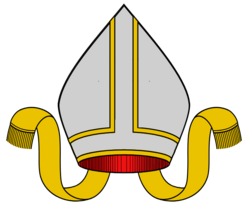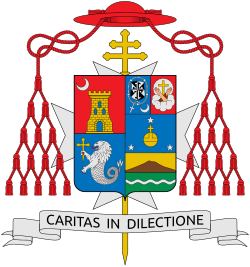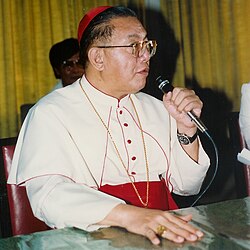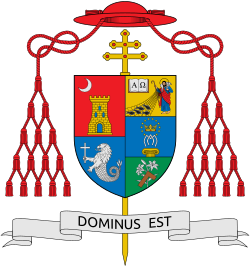Top Qs
Timeline
Chat
Perspective
Archdiocese of Manila
Archdiocese in the Philippines From Wikipedia, the free encyclopedia
Remove ads
The Archdiocese of Manila (Latin: Archidioecesis Manilensis; Filipino: Arkidiyosesis ng Maynilà; Spanish: Arquidiócesis de Manila) is a archdiocese of the Latin Church of the Catholic Church in Metro Manila, Philippines, covering the cities of Manila, Makati, Mandaluyong, Pasay, and San Juan, the Embo barangays of Taguig that are formerly part of Makati, and EDSA Shrine in Quezon City. Its episcopal see is the Minor Basilica and Metropolitan Cathedral of the Immaculate Conception, also known as the Manila Cathedral, located in Intramuros, the old colonial city of Manila. The Blessed Virgin Mary, under the title of the Immaculate Conception, is principal patroness of the archdiocese as well as the country.
The Archdiocese of Manila is the oldest in the Philippines, created in 1579 as a diocese and elevated to the rank of metropolitan archdiocese in 1595. Since its last territorial changes in 2003, the Archdiocese of Manila is the metropolitan see of the ecclesiastical province of the same name, which includes seven dioceses in other parts of the National Capital Region such as Antipolo (Marikina), Cubao, Kalookan, Novaliches, Parañaque, Malolos (Valenzuela), and Pasig, as well as four dioceses in the surrounding provinces of Cavite (Diocese of Imus), Rizal (Diocese of Antipolo), Bulacan (Diocese of Malolos), and Laguna (Diocese of San Pablo).
In addition, the archdiocese is also de facto overseer of the Military Ordinariate of the Philippines, as well as the Apostolic Vicariates of Puerto Princesa and Taytay in Palawan, alongside all exempt dioceses of the Holy See (with the vicariates under the jurisdiction of the Dicastery for Evangelization).
The archdiocese also owns, operates, and manages various extraterritorial assets and temporalities, such as the radio station DZRV Radio Veritas 846 kHz along with Our Lady of Veritas Chapel (both in Quezon City) and its transmitter (Taliptip, Bulakan); the Mount Peace and Saint Michael retreat houses (Baguio City and Antipolo City); and Redemptoris Mater Archdiocesan Seminary of the Neocatechumenal Way (Parañaque City) located at the dioceses of Cubao, Malolos, Baguio, Antipolo, and Parañaque, respectively. Additionally, the archdiocese is among the top 100 shareholders of the Bank of the Philippine Islands.[5]
Since June 24, 2021, Cardinal José Fuerte Advíncula has been the 33rd Archbishop of Manila.[6]
Remove ads
History
Summarize
Perspective

Per the efforts of conquistador Martín de Goiti – who founded the City of Manila by uniting the dominions of Sulayman III of Namayan, Sabag, Rajah Ache Matanda of Maynila who was a vassal to the Sultan of Brunei, and Lakan Dula of Tondo who was a tributary to Ming dynasty China – the Diocese of Manila was established on February 6, 1579, through the papal bull Illius Fulti Præsidio by Pope Gregory XIII, encompassing all Spanish colonies in Asia as a suffragan of the Archdiocese of Mexico. Fray Domingo de Salazar, a Dominican from the Convent of San Sebastian in Salamanca, Spain, was selected by King Philip II of Spain to be bishop of the new diocese and was presented to the pope.[7][8]
Over the course of history and growth of Catholicism in the Philippines, the diocese was elevated in rank and new dioceses had been carved from its territory. On August 14, 1595, Pope Clement VIII raised the diocese to the status of an archdiocese with Bishop Ignacio Santibáñez its first archbishop. Three new dioceses were created as suffragans to Manila: Nueva Cáceres, Nueva Segovia, and Cebu. With the creation of these new dioceses, the territory of the archdiocese was reduced to the city of Manila and the adjoining civil provinces in proximity including Mindoro Island. It was bounded to the north by the Diocese of Nueva Segovia, to the south by the Diocese of Cebu, and to the southeast by the Diocese of Nueva Cáceres.[9]
During the Spanish period, the archdiocese was ruled by a succession of Spanish and Latino archbishops. In the 1600s, Fr. Joaquín Martínez de Zúñiga conducted a census of the Archdiocese of Manila, which encompassed most of Luzon, and he reported 90,243 native Filipino tributes;[10]: 539 10,512 Chinese (Sangley) and mixed Chinese Filipino mestizo tributes;[10]: 537 and 10,517 mixed Spanish Filipino mestizo tributes.[10]: 539 Pure Spaniards were excluded as they were exempt from tribute, with each tribute representing an average family of 6. Out of these, Martínez extrapolated a total population count exceeding half a million souls.[10]: 537
The 1762 British occupation of Manila during the Seven Years' War saw the temporary conversion of Sultan Azim ud-Din I of Sulu to Catholicism, the massive looting and destruction of ecclesiastical treasures, as well as the burning of churches by British soldiers, Sepoy mercenaries, and rebellious Chinese residents in Binondo. This episode was particularly damaging to Philippine scholarship as the monasteries holding archives and artefacts on the pre-colonial Philippine Rajahnates, Kedatuans, Sultanates, Lakanates, and Wangdoms and their conversion to Catholicism were either burnt, lost, or looted. An example would be the Boxer Codex, whose earliest owner Lord Giles of Ilchester had inherited it from an ancestor who stole it during the British Occupation.[11]
Nevertheless, peace was subsequently restored after, Catholic religious orders became the powerful driving force in the Archdiocese of Manila (with the exception of the Jesuits who were temporarily suppressed in Spanish lands due to their role in anti-imperialist movements in Latin America like the Paraguayan Reductions). Local Filipino secular clergy resented the foreign religious orders due to their near-monopoly of ecclesiastical positions, which violated the declarations of the Council of Trent, stating that once an place is no longer a missionary area but a regular diocese, friars are to surrender parishes to secular priests.[12] However, upon the suppression of the Jesuits, the Recollect Order took over the former’s parishes and surrendered their parishes to local secular clergy, temporarily assuaging Filipino yearnings.[12] However upon the restoration of the Jesuits, the Recollects were forced to retake their parishes from the secular priests. The opposition of the religious orders against an autonomous diocesan clergy independent of them lead to the martyrdom of Filipino diocesan priests Mariano Gómez, José Burgos, Jacinto Zamora – collectively known as Gomburza –who were wrongly implicated in the Cavite Mutiny. This stemmed from fears that, because the priest Miguel Hidalgo lead the Mexican war of independence against Spain, the same could happen in the Philippines.[12] Furthermore, Governor-General Rafael Izquierdo y Gutiérrez, who was a Freemason, upheld the vow to protect his Masonic brothers upon discovering the Mutiny was led by some of them (Máximo Innocencio, Crisanto de los Reyes, and Enrique Paraíso), and so shifted the blame to the Gomburza since they had inspired ethnic pride among Filipinos with their clerical campaign.[12] Izquierdo asked the Catholic hierarchy in the person of Archbishop of Manila Gregorio Melitón Martínez to have them declared heretics and defrocked, but the latter he refused as he believed in the trio’s innocence. As the colonial government executed the Gomburza, church bells across the colony were rung in mourning.[12] This inspired the Jesuit-educated nationalist José Rizal to form La Liga Filipina, to seek reforms from Spain and recognition of local clergy.
Rizal himself was executed in 1896 and La Liga Filipina dissolved. As cries for reform were ignored, formerly loyal Filipinos were radicalized and the 1896 Philippine revolution was triggered when the Spanish discovered the anti-colonial secret organisation Katipunan (formed with Masonic rites in mind despite Catholic opposition to Freemasonry, yet were dedicated to the martyred Catholic priests as "Gomburza" was a password in the Katipunan). The United States took the Philippines from Spain following the 1898 Spanish–American War; this turned the fighting into the 1899–1902 Philippine–American War, with many Katipuneros devastated their fellow American Masons killed the Katipunan, as American lodges dismissed the Revolutionary Masonic lodges as "irregular" and illegitimate,[13] and Philippine Freemasonry placed under control of the Grand Lodge of California.[14] Under American colonial control, the Catholic Church was disestablished as the state church of the Philippines, with the postwar period seeing some churches restored in the Art-Deco style. There was a looming threat of apostasy and schism with the rise of anti-clerical Philippine Freemasonry and the establishment of the Philippine Independent Church due to Filipino anger against Spanish ecclesiastical corruption.[15] In response, Pope Leo XIII in 1902 excommunicated all adherents of the Philippine Independent Church, yet supported Philippine political independence with a policy of reinforcing orthodoxy and reconciliation. This resulted in a majority of Filipinos remaining in full communion with the Holy See, and a good number of those who had left the Church returning.

On April 10, 1910, Pope Pius X carved out from Manila the Diocese of Lipa, with jurisdiction over the provinces of Batangas, Tayabas, Marinduque, Laguna and Mindoro, and some parts of Masbate. In May 1928, Pope Pius XI established the Diocese of Lingayen, using territory from Manila and Nueva Segovia. In this creation, twenty-six parishes were separated from Manila.
December 8, 1941, marked the beginning of the Japanese occupation of the Philippines.[16] World War II marked a period of irreplaceable loss to the Archdiocese of Manila. The combination of violent theft and arson done by the Japanese and indiscriminate carpet bombing by the Americans during the Battle of Manila (1945) led to the permanent loss of many Gothic, Art-Deco, and Earthquake Baroque churches.[17] Interestingly, then-Father Rufino Jiao Santos (a future Archbishop of Manila) was taken captive by the Japanese, but was saved by combined Filipino and American forces.

In the aftermath of the war, in September 1942, Pope Pius XII declared Our Lady of Immaculate Conception as the Principal Patroness of the Philippines by virtue of the papal bull, Impositi Nobis, along with Pudentiana and Rose of Lima as secondary patrons.[18]
Due to the heavy damages resulting from World War II, the Manila Cathedral underwent major rebuilding from 1946 to 1958. The Parish of San Miguel served as temporary pro-cathedral until the Manila Cathedral was reopened and consecrated in 1958.
On December 11, 1948, the Apostolic Constitution Probe Noscitur further divided the Archdiocese of Manila by placing the northern part of the local church in the new Diocese of San Fernando. On November 25, 1961, the Archdiocese of Manila was again partitioned with the creation of the Diocese of Malolos for the province of Bulacan in the north and the Diocese of Imus for the province of Cavite to the south.
Pope John Paul II declared the Manila Cathedral a minor basilica in 1981 through the motu proprio Quod ipsum, issued as a papal bull.[19] In 1983, the province of Rizal, the city of Marikina, and northeastern portions of Pasig, were placed under the new Diocese of Antipolo.
The archdiocese witnessed many grace-filled church events such as the Second Synod of Manila (1911), the Third Synod of Manila (1925), the 33rd International Eucharistic Congress (1937), the First Plenary Council of the Philippines (1953), the papal visit of Pope Paul VI (1970), the Fourth Synod of Manila (1979), the papal visits of Pope John Paul II (the first in 1981 and the second in 1995), the National Marian Year (1985), the National Eucharistic Year (1987), the Second Plenary Council of the Philippines (1991), the Second Provincial Council of Manila (1996), the Fourth World Meeting of Families (2003), and the papal visit of Pope Francis (2015).
With the increasing population of the metropolis, Cardinal Jaime Sin, its thirtieth archbishop, requested Pope John Paul II to divide the Archdiocese since according to him, the "ecclesiastical area was too big, too extensive, too populous, and too complex for one archbishop to handle properly".[20] In response, the Vatican carved out two more dioceses from the Archdiocese in 2002: the Diocese of Novaliches and the Diocese of Parañaque. In 2003, three more dioceses were erected: Cubao, Kalookan, and Pasig.
Remove ads
Coat of arms
The arms of the metropolitan see of Manila is an adaptation of the arms granted by Philip II of Spain to the insigne y siempre leal ("distinguished and ever loyal") city of Manila in 1596. The silver crescent represents the Immaculate Conception, patroness of the Manila Cathedral and of the entire Philippines. The tower represents God as described in Psalm 60: turris fortis contra inimicum (turris fortitudinis a facie inimici in the Galician psalter), and its three windows represent the Blessed Trinity: Father, Son and Holy Ghost. The sea lion represents the Philippines, then an ultramar (overseas) territory of Spain, and the pilgrim's cross which may be easily fixed on the ground symbolizes both the faith of the Filipino people and their missionary role in spreading the faith.[21]
Remove ads
Ordinaries
Summarize
Perspective

Archbishops
The seat of the archbishop is at Manila Cathedral. The Archbishop of Manila is widely regarded (de facto) as the primate of the Catholic Church in the Philippines.[22] The archdiocese has held the title "Metropolitan of the Philippines" (Spanish: Metropolitano de las Islas Filipinas) since its elevation in 1595.[23]
After the first Bishop of Manila Domingo de Salazar, the diocese became an archdiocese and there have been nineteen archbishops of Spanish origin. In 1903, the archdiocese received its first American archbishop, Jeremiah James Harty from St. Louis, Missouri. After him, the lone Irishman Michael J. O'Doherty was appointed in 1916, leading the church as Filipinos petitioned for sovereignty from the United States, and through the Japanese occupation during World War II.
When O'Doherty died after Philippine independence in July 1946, coadjutor archbishop Gabriel Reyes became the first native Filipino in the position. Reyes' successor, Archbishop Rufino Jiao Santos, became the first Filipino cardinal in 1960. Since him, all archbishops have been of Filipino origin and are customarily made cardinals.
After the departure of Cardinal-Archbishop Luis Antonio Tagle to become prefect of Congregation for the Evangelization of Peoples on February 9, 2020, Auxiliary Bishop Broderick Pabillo was apostolic administrator for 17 months during the COVID-19 pandemic. Tagle's successor, then-Archbishop of Capiz José Fuerte Advíncula, was enthroned on June 24, 2021.[24]
Timeline

Coadjutor Archbishops
Auxiliary Bishops
Remove ads
Priests of this diocese who became bishops
- Francisco Sales Reyes y Alicante – appointed Bishop of the Archdiocese of Nueva Caceres (now Archdiocese of Caceres) in 1925
- Artemio Gabriel Casas – appointed first Bishop of Imus in 1961; later appointed as Archbishop of Jaro
- Felix Paz Perez – appointed second Bishop of Imus in 1969
- Antonio Tobias – appointed auxiliary bishop of Zamboanga in 1982, then Bishop of Pagadian (1984–1993), Bishop of San Fernando de La Union (1993–2003), and finally Bishop of Novaliches until his retirement in 2019.
- Francisco Capiral San Diego – appointed Coadjutor Vicar Apostolic of Palawan in 1983, then became Apostolic Vicar of Puerto Princesa (1987–1995), Bishop of San Pablo, Laguna (1995–2003), and later, the first Bishop of the Diocese of Pasig (2003–2010).
- Francisco Mendoza de Leon – Auxiliary Bishop of the Diocese of Antipolo (2007–2015), became its coadjutor (2015), and its fourth diocesan bishop (2016–2023).
- Socrates Villegas, O.P. – third Bishop of Balanga (May 3, 2004 – November 4, 2009) and Archbishop of Lingayen-Dagupan (November 4, 2009 – present)
- Ruperto Santos, fourth Bishop of Balanga (April 1, 2010 – July 22, 2023) and fifth Bishop of Antipolo (July 22, 2023 – present)
- Roberto Gaa, 3rd Bishop of the Diocese of Novaliches (August 24, 2019 – present)
- Jose Alan Dialogo, 5th Bishop of the Diocese of Sorsogon (October 15, 2019 – present)
- Arnaldo Catalan, Apostolic Nuncio to Rwanda (January 31, 2022 – present)
- Rufino Sescon, O.P. – fifth Bishop of Balanga (March 1, 2025 – present)
Remove ads
Suffragan dioceses and bishops
Remove ads
Formation of priests
The archdiocese administers San Carlos Seminary, the archdiocesan major seminary which caters to the formation of future priests for the archdiocese and for its suffragan dioceses. Located in Guadalupe Viejo, Makati, it has a pre-college program (senior high school and formation year), a college program (A.B., philosophy), and a graduate school (master's program in theology or pastoral ministry), as well as a formation houses for future priests committed to serve the Filipino-Chinese communities in the country (Lorenzo Ruiz Mission Society) and a center for adult vocations (Holy Apostles Senior Seminary). The archdiocese also operates Our Lady of Guadalupe Minor Seminary for young men at the secondary school level. It is located a few blocks from San Carlos Seminary.
Remove ads
Schools
The Roman Catholic Archbishop of Manila Educational System (RCAMES) comprises 27 archdiocesan and parochial schools. The archbishop of Manila exercises authority in each member school and appoints a superintendent for the entire system to implement decisions and resolve issues. The member schools are:[25]
- Ermita Catholic School
- Espiritu Santo Parochial School
- Guadalupe Catholic School
- Holy Child Catholic School
- Holy Family Parochial School
- Holy Trinity Academy
- Jaime Cardinal Sin Learning Center
- Malate Catholic School
- Manila Cathedral School
- Our Lady of Fatima Catholic School
- Our Lady of Guadalupe Minor Seminary
- Paco Catholic School
- Sacred Heart of Jesus Catholic School
- Saint Anthony School
- Saint Joseph School - Gagalangin
- Saint Joseph's School of Pandacan
- Saint Peter the Apostle School
- Saint Pius X Parochial School
- San Felipe Neri Parochial School
- San Isidro Catholic School
- San Juan de Dios Educational Foundation
- San Pablo Apostol Learning Center
- San Rafael Parochial School
- Santa Clara Parish School
- Santa Isabel College
- St. John the Baptist Catholic School
- The Nazarene Catholic School
Remove ads
See also
Wikimedia Commons has media related to Roman Catholic Archdiocese of Manila.
References
External links
Wikiwand - on
Seamless Wikipedia browsing. On steroids.
Remove ads



































































































